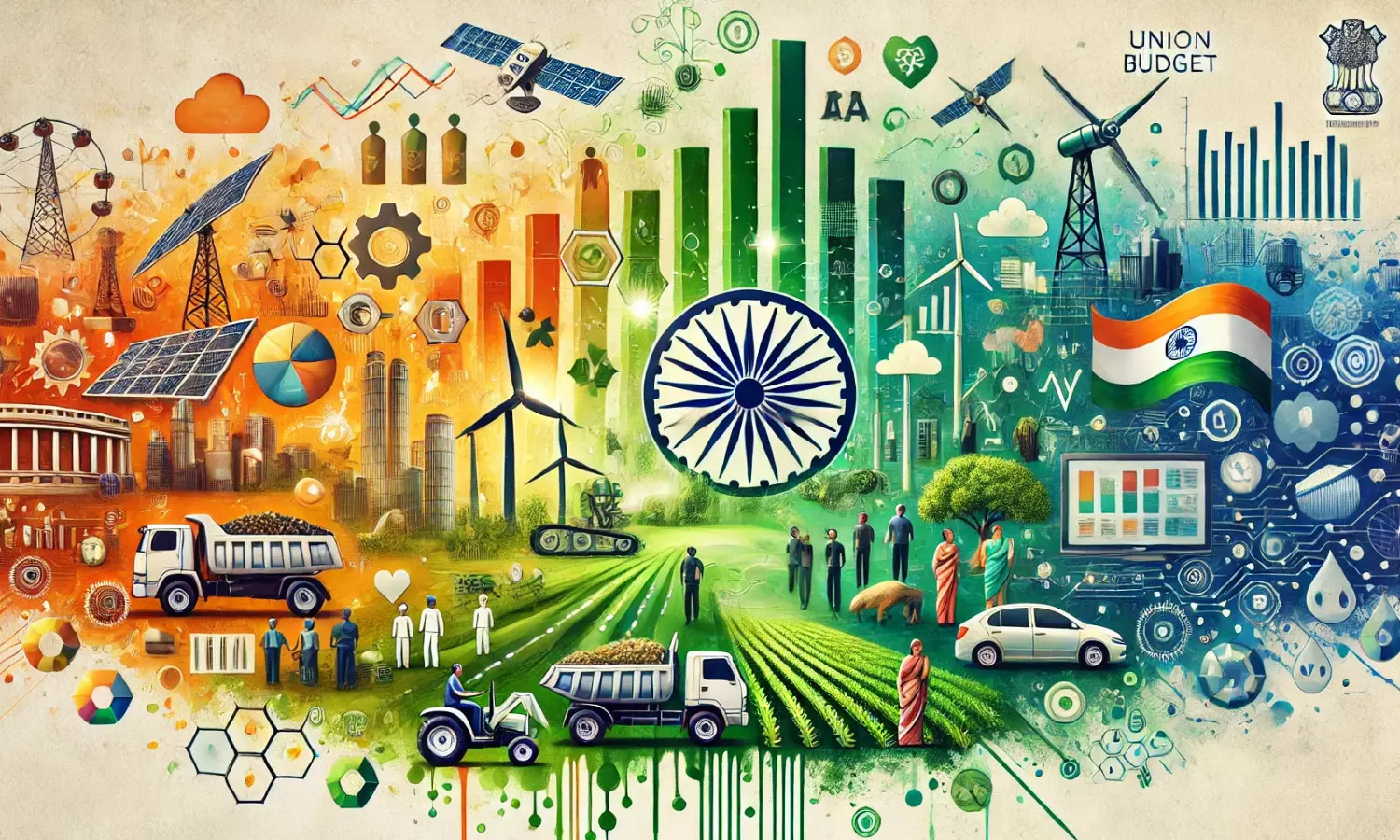Key Features of Union Budget 2025-26 | No Income Tax Up To Rs 12 Lakh
Discover the key features of Budget 2025-2026: Agriculture, MSMEs, Education, Healthcare and More

The Union Budget 2025-26, presented by Finance Minister Nirmala Sitharaman, focuses on accelerating economic growth, fostering inclusive development, boosting private sector investments, and enhancing the spending power of India’s middle class. Anchored in the vision of Viksit Bharat, it aims to strengthen India’s global position through transformative reforms in agriculture, MSMEs, infrastructure, and exports.
The Budget emphasizes digital inclusion, social welfare, and sustainability while driving fiscal consolidation, tax reforms, and investment-led growth to build a resilient and prosperous economy.
"The Budget 2025, driven by the "Viksit Bharat 2047 Vision," is praiseworthy for its comprehensive focus on inclusive growth, sustainability, and economic resilience, with strategic investments in agriculture, MSMEs, education, healthcare, and renewable energy. Its progressive tax reforms, women empowerment initiatives, and infrastructure push reflect a forward-thinking approach.
However, the ambitious fiscal deficit target of 4.4% amid increased capital expenditure raises concerns about fiscal stability. Additionally, while the budget outlines transformative schemes, the real challenge lies in effective implementation, addressing bureaucratic bottlenecks, and ensuring that benefits reach the grassroots level without widening regional and socio-economic disparities."
1. Budget Theme: Viksit Bharat 2047 Vision
- Focus on inclusive growth, sustainable development, and strengthening India’s position globally.
- Aims for zero poverty, 100% quality education, universal healthcare, skilled workforce, women’s economic participation, and positioning India as the food basket of the world.
2. Growth Drivers: The Four Engines
- Agriculture: Enhancing productivity, sustainability, and farmer welfare.
- MSMEs: Supporting entrepreneurship, exports, and job creation.
- Investments: Boosting infrastructure, education, healthcare, and innovation.
- Exports: Strengthening global trade and manufacturing capabilities.
3. Key Sectoral Initiatives
A. Agriculture & Rural Development
- PM Dhan-Dhaanya Krishi Yojana: Targeting 100 low-productivity districts to enhance crop diversification, irrigation, storage, and credit access.
- Mission for Aatmanirbharta in Pulses: Special focus on Tur, Urad, and Masoor.
- Comprehensive Programme for Fruits & Vegetables: Promoting production, processing, and farmer income.
- Makhana Board in Bihar and Urea Plant in Assam to boost regional agricultural economies.
- Kisan Credit Card (KCC) Limit Raised: From ₹3 lakh to ₹5 lakh.
B. MSMEs & Startups
- Revised MSME Classification: Enhanced investment and turnover limits.
- Credit Guarantee Cover: Increased to ₹10 crore for MSMEs, ₹20 crore for startups.
- Scheme for First-Time Entrepreneurs: Supporting 5 lakh women, SC/ST entrepreneurs.
C. Education & Healthcare
- 50,000 Atal Tinkering Labs in government schools.
- Expansion of Medical Education: Adding 10,000 new medical seats annually.
- Day Care Cancer Centres: Set up in all district hospitals within 3 years.
- Centre of Excellence in AI for Education: With an outlay of ₹500 crore.
D. Infrastructure & Urban Development
- PM Gati Shakti: Data access for the private sector to boost PPPs.
- Urban Challenge Fund: ₹1 lakh crore for smart city development.
- SWAMIH Fund 2: ₹15,000 crore to complete 1 lakh housing units.
- Jal Jeevan Mission: Extended till 2028 for 100% coverage
- Asset Monetization Plan (2025-30): ₹10 lakh crore investment
- 50-year Interest-Free Loans to States: ₹1.5 lakh crore for reforms
- Maritime Development Fund: ₹25,000 crore for long-term financing
E. Energy & Sustainability
- Nuclear Energy Mission: 100 GW target by 2047.
- Renewable Energy Focus: Support for solar PVs, EV batteries, wind turbines.
4. Major Tax Reforms
A. Personal Income Tax
No Income Tax for Income up to ₹12 lakh (₹12.75 lakh with standard deduction for salaried).
Revised Tax Slabs:
|
|---|
- A tax rebate is provided for taxpayers with normal income up to ₹12 lakh (excluding capital gains), ensuring no tax is payable after slab rate benefits.
B. Corporate & MSME Taxation
- Increased Credit Guarantee Cover: Additional ₹1.5 lakh crore in credit over 5 years.
- Tax Incentives for Startups: Period of incorporation is extended till 2030 for tax benefits.
C. Indirect Taxes (Customs & GST)
- Customs Duty Rationalization: Reduction of tariff rates to 8 slabs.
- Duty Exemptions: On critical minerals, EV battery components, and medical drugs.
- GST Reforms: Simplified compliance, track & trace mechanisms, and extended export deadlines.
5. Fiscal Policy Highlights
- Fiscal Deficit Target (2025-26): 4.4% of GDP (down from 4.8% in 2024-25).
- Total Expenditure: ₹50.65 lakh crore.
- Capital Expenditure: ₹11.54 lakh crore.
- Support to States: ₹1.5 lakh crore interest-free loans for capital projects.
6. Reforms & Governance
- New Income-Tax Bill: Simplified, reducing litigation and increasing transparency.
- Jan Vishwas Bill 2.0: Decriminalizing over 100 legal provisions to improve ease of doing business.
- FDI in Insurance: Increased from 74% to 100% with conditions to invest premiums in India.
7. Social Welfare Initiatives
- PM SVANidhi Revamp: Enhanced loans, UPI-linked credit cards for street vendors.
- Gig Workers’ Welfare: Identity cards and health coverage under PM Jan Arogya Yojana.
- Women Empowerment: 70% female participation in economic activities targeted.
- BharatNet: Broadband for all rural secondary schools and PHCs.
8. Technological Advancements & Innovation
- PM Research Fellowship: 10,000 fellowships in IITs/IISc
- National Geospatial Mission: Modernizing land records
- Gene Bank for Crop Germplasm: 10 lakh germplasm lines
- Private Sector-Led R&D: ₹20,000 crore for innovation
With strategic investments in key sectors, transformative reforms, and a strong emphasis on social welfare, digital infrastructure, and fiscal discipline, the Budget aims to empower every section of society while positioning India as a global economic leader in the years to come.

